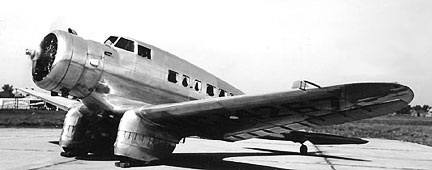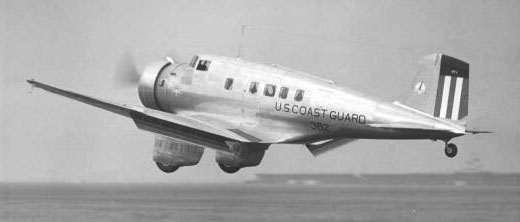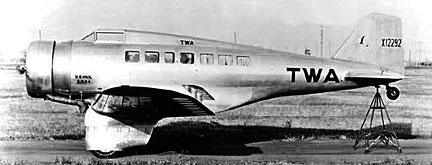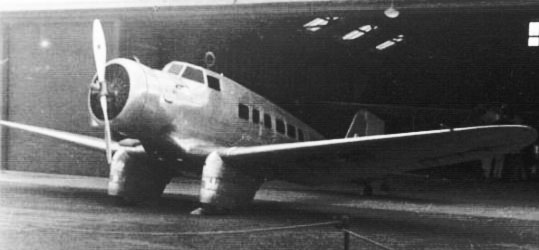Northrop Delta Golden Age Airliner
Northrop Delta Early Airliner
The Northrop Delta
High-Speed, Long-range Transport Plane
 In its general design, the Northrop
Delta low-wing transport monoplane, developed for long-range, high-speed cargo
and passenger service, is similar to the
Northrop Alpha transports now flying
the Los Angeles-New York overnight
air mail (in 1933). It had, however, more than 45
per cent greater payload capacity and increased performance for a given horsepower. These features were the result of
extended structural developments and
wind tunnel investigations. Refinements
of structural details were made
which, combined with the use of the new
24 SRT Alclad instead of 17ST formerly
used, provided an all-metal full cantilever airplane of 45 per cent greater
gross loading than the Alpha with only
a small increase in the empty weight.
In its general design, the Northrop
Delta low-wing transport monoplane, developed for long-range, high-speed cargo
and passenger service, is similar to the
Northrop Alpha transports now flying
the Los Angeles-New York overnight
air mail (in 1933). It had, however, more than 45
per cent greater payload capacity and increased performance for a given horsepower. These features were the result of
extended structural developments and
wind tunnel investigations. Refinements
of structural details were made
which, combined with the use of the new
24 SRT Alclad instead of 17ST formerly
used, provided an all-metal full cantilever airplane of 45 per cent greater
gross loading than the Alpha with only
a small increase in the empty weight.
In the Delta model, the pilot was placed forward of the passenger compartment and just to the rear of the firewall to provide maximum visibility" The cockpit is covered with a sliding enclosure. The fuselage diameter is large enough to permit a seating arrangement of either two or three abreast, an aisle between.
Features of easy servicing and maintenance include a quickly detachable rubber-bushed alloy steel engine mount, jigged inter-changeable cowling. Fully enclosed ball bearings on ail controls and oversize bushings and joints at all points of wear.
Stability is positive in all directions enabling a level course to be maintained for long periods without touching the controls. Full lateral control is maintained beyond the stalling point of the wing, even with flaps down.
A reduction in landing speed and length of glide has been obtained by the use of split trailing edge flaps. With the flaps in full down position tire maximum lift of the airfoil is increased 35 per cent and the drag by 300 per cent. The combination extends the usefulness and safety of the ship as many small fields, hitherto considered unsafe, can be flown into and out of by the average pilot.
The fuselage is of all-metal stressed skin monocoque structure with longitudinal stiffeners and large oversize reinforcing rings. Permanent jigged assembly of the fuselage and, center section forms a rigid integral unit of these two parts. Six gasoline tanks of 340 gallons capacity are installed in the center section, permitting long range operation when desired without encroaching upon cargo space within the fuselage.

The attractively finished cabin provides accommodations for eight passengers and contains approximately 200 cubic feet of available space. The cabin is 57 inches wide and 60 inches high and the fully upholstered seats are 19 inches wide, with an aisle between offering comfort and ample leg room. Individual windows, reading lights, ash trays and ventilation control are provided at each seat. A heating and ventilation system, controlled from the cockpit, admits into the cabin either heated air or air at outside temperature. The cabin is unusually quiet, due to the use of sound-deadening insulation throughout.
The passenger compartment entry door is on the left side of the fuselage and an emergency exit is available from the forward right side of the ship. A lavatory may be installed by eliminating one of the rear seats.
Thirty-five cubic feet of space is available for cargo in a compartment aft of the cabin. A Wright Cyclone SR 1820 F-3 rated 710 hp at 5,500 feet altitude or a P. & W. Hornet of similar horsepower rating is used. These engines use 87 octane gasoline, so when a lower octane fuel is desired there will be a small decrease in performance corresponding to the decreased horsepower output. The metal propeller used is a Hamilton Standard adjustable pitch type.
Four quickly detachable fittings form
the engine mount attachment to the firewall. The use of specially designed rubber
bushings prevents a large part of the engine and propeller vibration from being transmitted to the cabin. 
A stainless steel exhaust collector ring is provided. Engine controls, wiring, fuel system, and instrument leads have quickly detachable connections which make possible replacement of the entire power plant assembly within 30 minutes. Easy access to the engine accessories is possible through inspection cover plates or by removal of the cowling which is assembled in three sections. The oil tank of 20 gallons capacity is mounted on the engine bearing members and forms a unit which is removable with the power plant assembly. The tank is accessible for service and as a result of ventilation, proper oil temperatures are maintained, even under severe operating conditions.
The landing gear consists of four cantilever Cleveland oleopneumatic struts: with streamline fairing enclosing the entire assembly. All parts of the gear, including the fairing, are quickly detachable, making tire change and wheel inspection a rapid operation. Carefully developed streamlining provides an aerodynamic efficiency in the gear almost equal to full retraction but with greater simplicity and less weight.
Wheel tread is 9 feet. The Bendix internal expanding brakes are differentially controlled by rudder pedals and the brakes may be set with a parking lever in the cockpit. Tires are 36 x 8 inches.
Installation of Floats
Floats are easily installed; a bulkhead placed in the junction of the wing and center section distributes all landing loads and provides easy attachment for float struts and brace wires. Water rudders are used to assist in taxiing cross-wind and in congested areas. Skis are likewise easily installed except that special oteo struts are attached through rigid struts to the regular landing gear fitting in the center section.
Split trailing edge flaps are mounted on the under side of the wing as the most effective means of increasing lift and drag for slow, restricted landings. In full down position the maximum lift of the airfoil is increased 35 per cent and the drag by 300 per cent. Landing speeds are reduced approximately 15 m.p.h. by the use of flaps. With flaps in down position the ailerons remain positive in action and are effective even beyond the stall of the wing. The flaps are operated from the cockpit either manually or by a switch controlled electric motor.
The wing is of all-metal stressed skin multi cellular construction By the use of stiffeners of high efficiency a wing of unusual strength-weight ratio is obtained.

Specifications
Crew: 1 |



